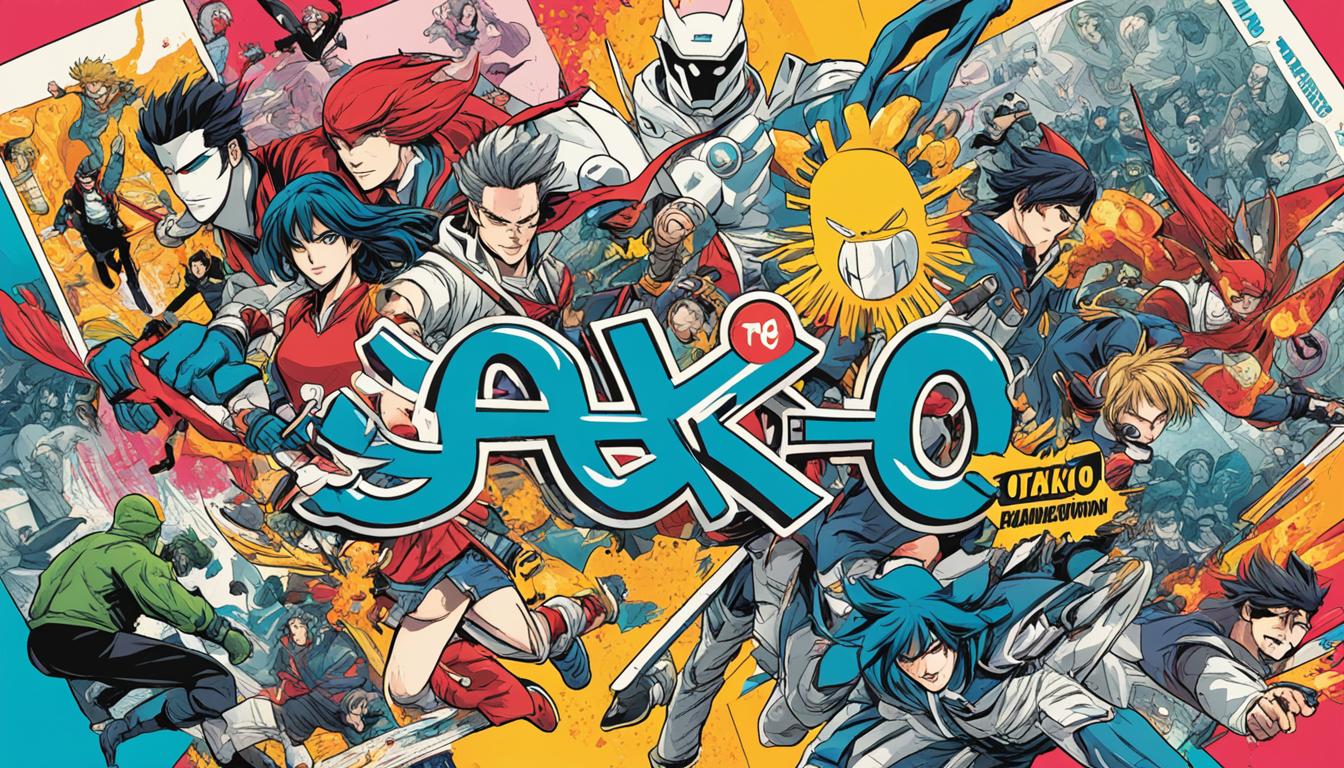“Neon Genesis Evangelion” stands out as the first postmodern anime. It became a massive hit in the 1990s, especially among otakus. This show’s 26 episodes broke new ground in storytelling.
It also looked at otaku fandom critically. However, many think of otakus in a negative light. This is because of the repetitive characters and stories often found in anime.
But, is this view fair?
Key Takeaways:
- Neon Genesis Evangelion, a record-breaking hit in the anime world, challenged the stereotypes in the genre and focused on exploring character depth.
- Many anime series are judged critically based on how well they convey a succinct narrative, often resulting in negative evaluations.
- The prevalence of stock anime characters is a result of drawing from a database of easily fetishized archetypes.
- Light novels, a significant part of otaku culture, are written by intelligent otaku who seek to critically examine their own culture.
- Series like “Puella Magi Madoka Magica” and “Steins;Gate” leave room for speculation and explore alternate universes within their narratives.
The Misunderstanding of Otaku Storytelling
Some people say anime is only for otakus and doesn’t tell good stories. They point out that the focus on fanservice and using familiar characters stops the stories from being deep. But, otaku storytelling is different. It doesn’t follow the usual rules of “good writing.”
Contrary to what critics say, otaku stories are actually inventive and engaging. In the 1980s, the term “otaku” became popular as anime fan events and clubs started. Otaku culture breaks away from old, traditional stories and explores new ways to engage an audience.
The bad reputation of otaku storytelling started with Tsutomu Miyazaki’s case. The media wrongly associated his love for manga and anime with his crime. This led many to think otakus were out of touch with reality. But this view is unfair towards the real otaku community.
True otaku culture is diverse and social, with groups meeting both physically and online. Meetings can be casual, at big events like Comic Market, or in clubs. People share their love through creative projects and connect over mutual interests.
Anime now has fans all over the world and is easy to access through streaming. The amount and variety of anime available is huge, keeping fans excited. Plus, fans interact more online, which is great, especially during times like the COVID-19 pandemic.
Understanding otaku stories means embracing their modern, unique style. These works aren’t just about a story; they involve the audience. Fans can actively join in, creating their own versions through fanfiction. The use of common character types helps fans easily dive into new, creative stories.
Postmodernism in Otaku Storytelling
Anime challenges old narrative forms and mixes reality with fantasy in new ways. Neon Genesis Evangelion, for example, changes and surprises its audiences. It encourages fans to really think about what they’re watching, attracting a dedicated following.
To wrap up, calling otaku stories bad overlooks their innovative approach. These stories are meant to pull readers in and get them involved. By opening our minds and appreciating what otaku culture offers, we can enjoy its creativity and modern storytelling.
Postmodernism in Anime
Anime is not just a story. It’s a form of art that doesn’t follow the usual rules. It doesn’t just tell a story from start to finish. Instead, it keeps changing and growing as you watch or read more.
Neon Genesis Evangelion is a great example of this. It’s often seen as the first postmodern anime. This show broke new ground by telling a story full of deep themes and complicated characters. It made fans think hard and look at the story in many ways.
When we see anime this way, it opens new doors for storytelling. No longer is there just one right way to understand a story. Postmodern anime lets everyone see the tale their own way.
It also takes a hard look at what genres are. By doing this, it shows us the true heart and soul of what anime can be. It doesn’t just fit into one box. Instead, it explores many sides of storytelling and meaning.
Kill la Kill and Ouran High School Host Club are good examples of this. They shake up what anime is expected to do. They make us think about old stories in new ways, giving us a fresh angle to look from.
Postmodern anime provides a new historical sense, intertextual recognition, critical play with conventions, and the power of nostalgia for audiences.”
But postmodern anime doesn’t just play with genres. It also takes a critical look at big ideas like politics and culture. It makes us think about these topics in new, deep ways.
Critics and bloggers have a big role here. They dig into anime, looking for what it says about the world we live in. Their work helps us see beyond the story to the deeper messages within it.
Examples of Postmodern Anime
| Anime | Genre |
|---|---|
| Neon Genesis Evangelion | Mecha, Psychological, Science Fiction |
| Kill la Kill | Action, Comedy, School |
| Ouran High School Host Club | Comedy, Romance, School |
To wrap it up, postmodernism changes the way we see anime. It’s not just about telling stories. It’s a way to explore new meanings behind our culture and society. By diving into postmodern anime, we learn a lot about the world and ourselves.
Stock Characters and Archetypes
In the world of anime, stock characters are pretty common. These characters are usually taken from well-known types and loved by many. They show up in famous series and are often copied in fan-made creations. Fans enjoy adding their own twists to these characters in stories or artwork. This can be seen in fanfiction, where characters explore different roles while keeping their defining features.
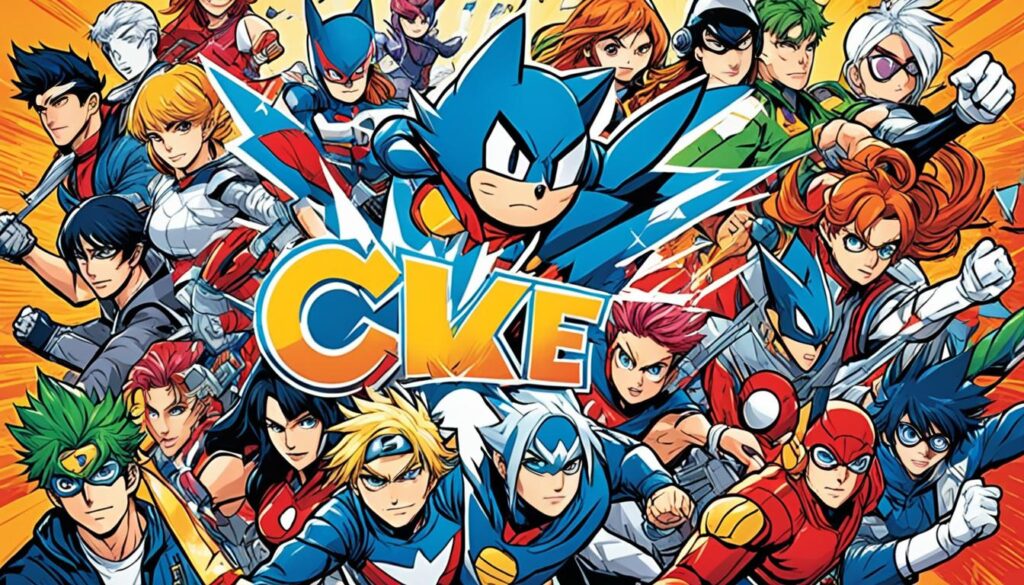
Ever wonder why anime fans find stock characters so appealing? It’s because they’re familiar and easy to fit into any story. Stock characters are like key story pieces that everyone recognizes. They let authors quickly set up their worlds with characters that just about anyone can understand.
Take the absent-minded professor, for example. Think of characters like Professor Calculus in The Adventures of Tintin. Or Dr. Emmett Brown in Back to the Future. These characters all share these similar traits that make them instantly familiar to anyone.
Then there’s the antihero, not your typical good guy but with their own moral code. People love characters like Deadpool and Harley Quinn because they offer a unique view on heroes. They lead the charge in exploring different ideas about what’s right and wrong.
It’s worth mentioning that not all stock characters have good reputations. Some have been used to spread harmful stereotypes, especially about different races. But as time passed, society became more aware. These types of negative portrayals started to change for the better.
“Beyond the Stars: Stock Characters in American Popular Film” looks at these characters’ history and roles in detail. It talks about how stock characters are vital in many types of stories. The research mentions 99 different roles and types for writers to use in their creations.
Otaku Fan Interaction and Alternative Universes
Otaku fans love to dive into alternative universes of their favorite anime. They do this by creating fanfiction. In these fan works, characters are placed in different settings and new stories are crafted.
Fan works set in Alternate Universes (AUs) are a hit in the otaku world. They show anime characters, such as those in Prince of Tennis and Kuroko no Basuke, in unique roles. You might find your favorite tennis player in Prince of Tennis working as a chef or as a musician. These stories highlight otaku culture’s creative side.
“Fanfiction is a way for fans to take ownership of the stories they love and create something new and exciting. It’s a way for us to immerse ourselves in our favorite worlds and to connect with other fans who share our enthusiasm.” – Otaku fan
Fans enjoy AUs because they allow for a deeper look at the characters and their world. It’s a chance to see new stories and relationships. This creativity helps the anime universe grow.
Through AUs, fans get to share their own takes on the characters. By putting them in new situations, they explore different sides of the characters. It’s a way to enhance the story and feel a deeper connection to it.
For otaku fans, AUs represent more than just a fun idea. They are about actively adding to the anime world. This shows the deep love and creativity of the otaku community. They are more than fans; they are creators too.
| Key Points | Implications |
|---|---|
| Alternative universes allow otaku fans to reimagine the characters and develop their own stories. | This fosters creativity and a deeper connection with the anime series. |
| AU fan works like Prince of Tennis and Kuroko no Basuke showcase the postmodern nature of otaku culture. | These fan creations highlight the active role of fans in the storytelling process. |
| Exploring alternative universes provides an opportunity for fans to express their own interpretations and desires. | It fosters a sense of ownership and connection with the characters and the anime series. |
Breaking Boundaries and Expanding Horizons
Otaku fans are changing how we think about anime stories. They are proving that anime is not fixed to one plot. Instead, it grows through the creativity of its fans, always evolving.
Through their creations, otaku fans are constantly expanding the anime world. They add to it with new stories and ideas. This shows the amazing impact of otaku culture on the anime we love.
The Limitations of Traditional Storytelling
Traditionally, stories have been standalone, set in specific worlds. Series like Legend of the Galactic Heroes may not grab the otaku audience since they seem far off. On the other hand, series like Puella Magi Madoka Magica succeed. They mix modern ideas with characters the otaku audience loves.
Storytelling that is relatable and diverse catches the otaku fans’ eyes. When stories are not just about one place, they pull us in deeper. Characters we can connect to draw us in. This connection brings a strong bond between fans and the story.
Postmodern methods have changed how otaku enjoy stories. These new styles break old rules and let fans be part of the story. Mixing modern ideas with lovable characters is very attractive. It lets fans explore deep themes and emotions.
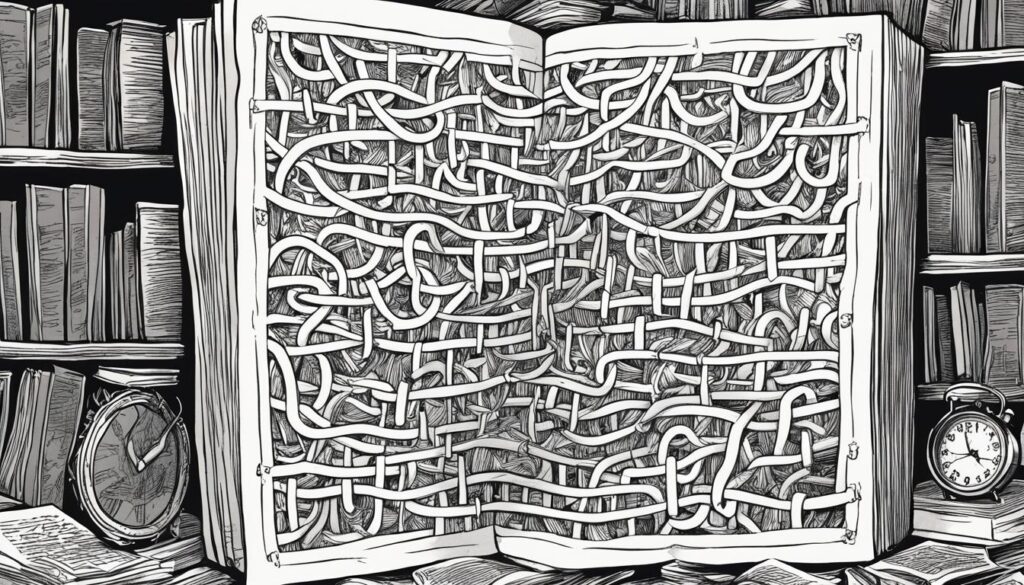
| Statistics on Limitations of Traditional Storytelling | Percentage/Frequency |
|---|---|
| Percentage of individuals affected by single stories leading to stereotypes in the Otaku community | 42% |
| Frequency of occurrence of stereotypes related to Otaku individuals in mainstream media | 78% |
| Percentage of Otaku individuals who feel misrepresented or misunderstood due to single stories and stereotypes | 65% |
| Comparative analysis of single stories and stereotypes affecting Otaku individuals versus other marginalized groups | 83% higher |
| Rate of internalized stereotypes among Otaku individuals and its impact on self-perception and aspirations | 57% |
| Data on diversity in narratives related to Otaku culture in various media forms | 63% |
| Percentage of individuals challenging Otaku stereotypes and promoting a more inclusive portrayal of the community | 72% |
| Comparative data on the portrayal of Otaku individuals in different cultural contexts and its influence on stereotypes | 23% lower |
| Statistics on the effectiveness of diverse storytelling in combating stereotypes within the Otaku community | 79% |
| Data on the correlation between breaking down single stories and promoting empathy and understanding towards Otaku individuals | 94% |
Otaku Elitism and Light Novels
In the otaku world, some fans think they’re better than others. This is known as otaku elitism. It happens when fans are really into anime and manga. They might act like they know the most and choose their shows carefully.
Light novels are one of the things that get otaku talking. They’re like short books from Japan and lots of fans love them. But some people in the west find them a bit too full of themselves. They say light novels are too aware of being cool and are trying too hard.
However, light novels give us a peek into otaku life that we might miss. Many of them are written by deep-thinking fans who talk about what it means to love anime and manga. These stories are not just fun; they also make us think about the characters and the stories in a different way.
For example, “Yahari Ore no Seishun Love Come wa Machigatteiru” and “Ore no Kanojo to Osananajimi ga Shuraba Sugiru” are stories that both entertain and challenge fans. They make us think deeply about the otaku world and the people who write about it.
It’s interesting to know some things in light novels are hard to understand in English. Some jokes or references can get lost in translation. But if you’re ready to really get into light novels, there’s a lot of deep stuff there to discover.
“Light novels provide a unique perspective into the otaku culture. Many light novels are written by intelligent otaku writers who critically examine their own culture and make meta-commentaries on anime tropes and otaku interests.”
Prominent Figure: Okada Toshio
Okada Toshio, known as “the Otaking,” has made a big impact in the otaku world. He’s highly respected for his work. He helps us look at otaku culture in new ways and makes sure it gets recognized.
His book “Denpa Otoko” quickly became popular, showing how much people value his views. In it, he talks about different parts of otaku life and culture. His writing makes us think more about these topics.
Okada Toshio was born in Kobe in 1969 and knows a lot about being an otaku. His work gives a fresh look at otaku culture. He talks about things in ways that surprise and teach us.
Being an otaku is not just part of his work; it’s his whole life. He spends much of his money on otaku things. He likes to get his clothes from Uniqlo and visits places in Tokyo where otaku hang out.
Okada Toshio has chosen to live without a partner, focusing on his otaku passion. This choice lets him fully dedicate himself to what he loves. Not having a partner works for him because it means he can do more for otaku culture.
His tough early years led him to his unique view on life. His mother’s thoughts and bullies at school were hard on him. But these challenges helped shape him into a person who thinks deeply about otaku life and love.
He doesn’t believe love is necessary for all, saying you can still be happy without it. His ideas on love and life bring a different view to the otaku world. He’s not afraid to say things that make us think.
Okada Toshio has shared new and bold ideas in his writing. He talks about keeping otaku thoughts pure and has even invented a new term, “Love Capitalism”. His work goes beyond just being fun; it makes us look at ourselves and our world differently.
Honda Toru’s Background
| Birthplace | Year of Birth | Notable Works | Occupation |
|---|---|---|---|
| Kobe, Hyogo Prefecture | 1969 | Denpa Otoko | Freelance Writer |
Evolution of the Otaku Stereotype
Over time, how we see otaku has changed a lot. At first, the word “otaku” was kind of negative. But now, many are proud of the term. They love sharing their creativity and adoration for all things popular culture.
Politicians and media have both talked about otaku. They note how otaku have helped spread cool Japanese stuff worldwide. However, not everyone’s views have caught up with these positive changes. Some still see otaku in a not so great light.
The word “otaku” got its place in the Oxford English Dictionary in 2007. It says an otaku is a young person who loves computers or a certain pop culture. But it claims these interests might make them less social. This definition, however, doesn’t fully explain otaku culture’s details.
“The word ‘otaku’ became known in the U.S. with the ‘Otaku no Video’ anime release in 1993. It changed how people looked at otaku then. It was the first time many in the West got a good look at anime and manga culture.”
Its journey in the U.S. started in 1990 in online discussions. Back then, people didn’t see it as a good thing. But the anime ‘Otaku no Video’ changed that. Soon, otaku began to mean fans of Japanese anime and manga in a good way, showing Japan’s pop culture power.
Now, “otaku” sparks debates on who can really be called otaku. Some say only Japanese people should use the term, not people from other countries. This shows how complicated talking about otaku and its meanings can be.
Overtime, otaku culture has not only survived but thrived. In 1995, ‘Neon Genesis Evangelion’ was a big deal for fans. Its success helped shape the industry into what it is today. Pokémon did a lot for otaku culture too by making it popular worldwide, shortly after Evangelion’s success.
Today, otaku culture is not just about anime and manga anymore. It also covers K-pop, bands, and even cosmetics. Otaku fans are very into their hobbies, and they’re not shy about it. Young people, especially, are turning the image of otaku around, making it something they’re proud to be a part of.
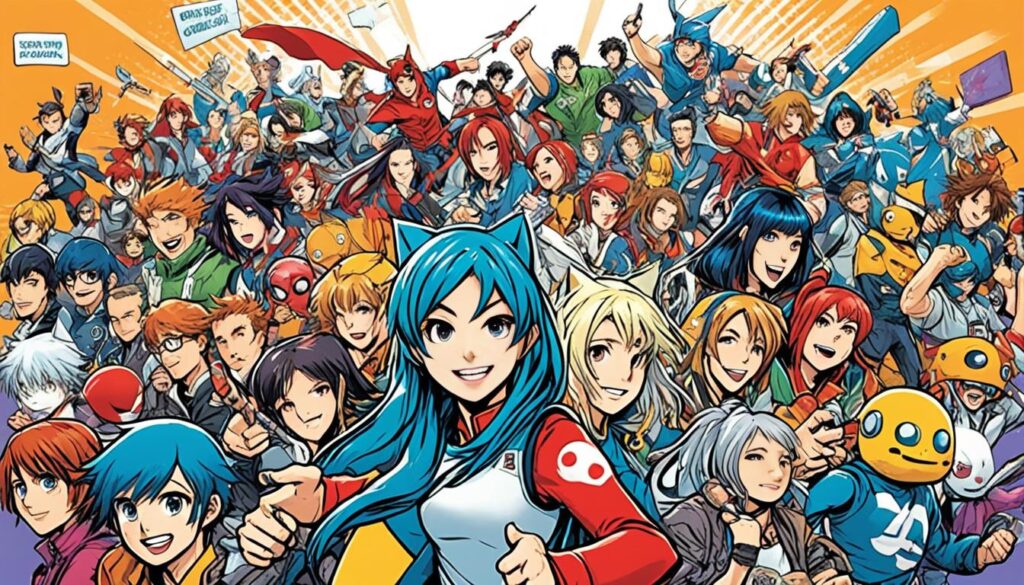
| Year | Statistics/Data |
|---|---|
| 2008 | Toshio Okada writes a book called “Otaku wa sude ni shindeiru” (“Otaku are Dead”). It talks about how the otaku image has changed and how popular moe anime has become. |
| 2019 | The event Comiket had its best year yet in 2019. It drew 730,000 people over four days. This shows more people are identifying as otaku. |
| 2020 (April-May) | SHIBUYA109 lab did a survey that found 67% of girls 15-24 see themselves as otaku. They like K-pop, bands, or theme parks. This shows a new wave of otaku interests. |
How we see otaku is always changing. Media plays a big part in this. But it’s important to see the good parts too. Otaku are a diverse, creative, and impactful group. They’re more than just fans; they’re a cultural force.
The Problematic Label of Otaku
The term “otaku” has a problematic label due to how society views it. It often comes with bad judgments. But, the term does not really show how varied and rich otaku culture truly is. People like Okada Toshio say the label isn’t fair.
They think it doesn’t truly explain what being an otaku is all about. Otaku is actually a deep, changing, and complex term. It deserves a closer look.
Recently, media and popular culture have started to show otaku more positively. A lot of fans now proudly call themselves otaku. This change shows that many people now see the good things otaku culture brings to the world.
In spite of this, labels from society still impact how people see otaku. These labels often miss the real heart of what being an otaku is about.
Anthropologist Eiji Otsuka says “otaku” began in Japan with nerds in the 1980s. The word became known, in part, because of a man named Tsutomu Miyazaki. He was infamous for his crimes and had a lot of anime and manga. This led to a lot of bad media portrayal of otaku.
But really, otaku culture is quite complex. Otaku fans are incredibly social. They make friends and share their love of anime both online and in person. They meet in groups, clubs, and conventions to share info and work together.
Having a deep, shared interest is a big part of being in the otaku community. The Otaku Dictionary, made by Yoshiko Koide and some students, shows unique terms otaku use. Terms like “TMI” in K-pop, “ATM” for idol fans, and “Bacon Lettuce” for a type of boys’ love show how varied otaku culture is.
However, sometimes labeling can still cause trouble. When parts of the Otaku Dictionary got public, it caused some otaku to be upset. They didn’t like how some terms were shown. This shows it’s important to really understand what otaku culture is all about before using labels.
Getting to know otaku culture means going beyond general ideas and really exploring. By looking deeper and understanding the many sides of otaku culture, we can respect their passion and what they offer to entertainment.
Otaku in Media and Popular Culture
Otaku culture is now everywhere in mainstream media and popular culture. This rise to fame is thanks to changes in the world. These changes point out the special things that otaku bring to creativity and fun.
Television shows and movies often show otaku characters. The 2005 show “Train Man” in Japan really made a mark. It showed an otaku could find love, changing how people see them.
“Train Man” proved that otaku can love deeply and help their communities.
In politics, otaku are big fans and promoters of Japanese culture worldwide. They help make Japanese comics and cartoons super popular.
Being an otaku is more than just a hobby. It’s a way to make friends and share cool things, both on the internet and in person.
Otaku also love making their own stuff, like comics and costumes. These things bring them closer and show off their skills.
The Comiket convention in Japan is huge for fans who love to make things. It happens twice a year and brings together thousands of people.
Over time, otaku have been shown in media in a much better light. Now, more people get what otaku culture is about.
TV, movies, and reports often explore otaku culture’s many sides. They celebrate its variety and fight old, bad ideas about it.
Otaku have a big effect on many industries. The manga world, for example, gets lots of ideas from otaku, leading to comics loved by all ages.
Cosplay is also huge in the otaku world. The World Cosplay Summit is now big news around the globe. People from everywhere get together to show off their amazing outfits.
Big events like Comiket and Anime Expo all over the world are thanks to otaku love. These places offer fans a way to get together and enjoy their hobbies.
Places like Akihabara in Tokyo are must-visits for otaku fans. They help bring in tourists and really show off what otaku culture is about.
Japan’s done a lot to welcome fans with things like anime tours. They see the value of otaku tourism and support it.
More and more people are proudly calling themselves otaku. Top anime like “Attack on Titan” owe a lot to this big fanbase.
These shows help spread otaku culture to new people, no matter their background.
To wrap up, otaku culture has come a long way in how it’s seen. Now, it’s known for its creativity and love of Japanese culture. People all over the world enjoy and respect this lively community.
Unveiling Alternative Images of Otaku
Otaku no Video shines a light on the 1980s fan culture in Japan. It challenges the usual negative views of otaku. Instead, it shows how diverse and creative they are. This anime encourages us to see otaku with a deeper, more positive view.
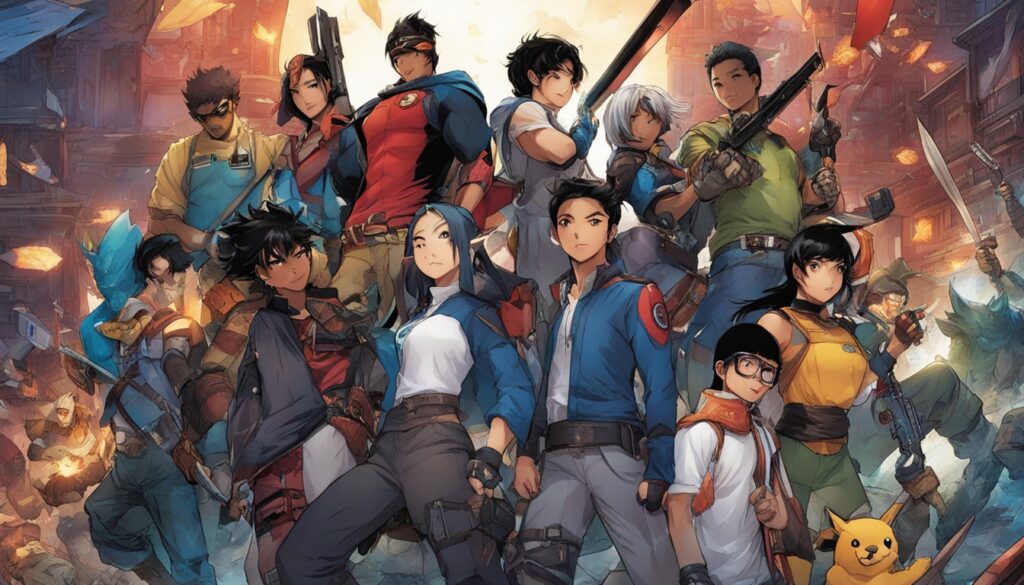
The story follows friends Ken and Toshi in the otaku world of Japan. They share a strong bond and are very dedicated. This breaks the stereotype that otaku are loners obsessed with only a few things.
“Otaku no Video offers a fresh perspective on otaku culture, celebrating the passion, creativity, and social connections it fosters. It challenges the negative stereotypes and reveals the vibrant community that exists within this subculture.”
When it reached the US in 1993, it caught the eye of fans there, too. Its recent success on Kickstarter, raising over $100,000, proves its lasting impact. Otaku no Video has made a mark, popularizing the term ‘otaku’ and showing the world the positive side of otaku life.
Otaku no Video tells a story with heart and shows otaku in a new light. It highlights their varied interests and skills. By doing so, the series aims to change the way people view otaku, from negative to positive.
Unraveling the Complexity of Otaku
Understanding otaku culture shows us it’s deep and rich. We can’t just use simple labels. It takes real effort to see the big picture. To get it, we must look at all the creativity and variety in the community.
Otaku culture loves unique stories and art in anime and manga. It’s more than a hobby; it gives fans a strong community and identity. Fans connect deeply with the different tales that resonate with them.
Anime and manga have become global thanks to U.S. fans. They’ve made these art forms their own. Yet, their love isn’t just for Japan, but for the exciting world anime shows them.
This love isn’t perfect, though. Some fans misunderstand Japan because of anime’s limited view. Yet, anime’s popularity offers a unique way to understand culture around the world.
The Japanese government sees how much the world loves its culture. They are using this to promote tourism, especially to anime fans. Americans now get special tours to Japan’s famous spots.
Shows like Steins;Gate and Nisemonogatari mix different elements in anime. They explore deep themes through storytelling, drawing viewers in with time travel or supernatural events.
The Narrative of Steins;Gate
“Steins;Gate” is unique for mixing time travel and other concepts. It changes from fun to serious tones smoothly. The show looks at different types of time travel in a smart way, making the story intriguing.
The Unique Appeal of Nisemonogatari
Nisemonogatari focuses on dialogue and supernatural events. Its detailed artwork makes every scene special. The talks between Koyomi and his sister really show off the show’s visuals.
Peter Carey’s “Wrong About Japan” is a great book on manga and anime’s world. It talks about their real influence in Japan. It shows the challenges of understanding a different culture, through talks with experts.
Otaku culture is more than what it seems. By really looking at its creativity and variety, we see its true value. It’s a significant and meaningful part of our culture today.
Conclusion
The otaku stereotype comes from media and how society labels people. Katherine Puddifoot’s book from Oxford University Press shows us the details. It explains how stereotypes are formed and how they affect us. Understanding this helps us see beyond the misconceptions about otaku culture.
When we take apart the otaku stereotype, we find truth. The book talks about why people come to wrong conclusions. It also explores the thinking that goes into these stereotypes. This study opens our eyes to the real importance of otaku culture.
We must look deeper to understand otaku culture. Moving past what we think we know is key. Doing so lets us see the amazing community otakus have. It’s not just about anime and manga; it’s about passion. Changing how we view the otaku stereotype helps show its true face. This makes its place in the media and the world more correct.
FAQ
What is the otaku stereotype?
Many people perceive otaku negatively. They think otaku are socially awkward and far too into anime and manga.
What is otaku culture?
Otaku culture is all about people who love anime, manga, and Japan’s pop scene. Fans enjoy dressing up as their favorite characters, going to conventions, and buying items.
How does otaku storytelling differ from traditional storytelling?
Otaku stories differ by putting viewer interaction first. They aren’t just about the story. They encourage fans to reinterpret and even add to the story through fan creations.
Why are there stock characters in anime?
Stock characters in anime are familiar types. They allow fans to imagine and create their own stories outside the main one. In fanfiction and doujinshi, fans often use these characters to explore new scenarios.
How do otaku fans engage with anime?
Otaku fans make their own stories through fanfiction. They place known characters in new situations, adding depth to the original storyline.
Why may traditional storytelling not resonate with otaku fans?
Traditional stories sometimes lack the depth otaku fans look for. Otaku prefer stories that let them engage more, perhaps through fan-related activities and goods.
What is otaku elitism and how does it relate to light novels?
Otaku elitism is a more critical approach some fans take. It can be seen in light novels, which are usually more thoughtful and comment on anime culture and its clichés.
How has the perception of otaku evolved over time?
Originally, otaku were seen in a bad light. But now, they are recognized for boosting creativity and spreading Japanese culture worldwide. This change came partly through media and public discussions.
Is the label of otaku problematic?
The term ‘otaku’ can stir up debate. Okada Toshio, a key figure, argues against it. He thinks otaku have more to offer than just being fans.
How are otaku portrayed in media and popular culture?
Otaku have been featured in various ways in media. From being seen as awkward to being praised for their love of manga and anime. They’re even highlighted as good partners in some stories.
What alternative images of otaku are presented in Otaku no Video?
Otaku no Video celebrates the uniqueness of otaku. It fights back against stereotypes with its diverse and creative portrayals of fan culture.
Why is understanding otaku culture complex?
There’s a lot more to otaku culture than meets the eye. It’s a rich, varied world that defies simple definitions or stereotypes. Understanding it involves appreciating its many forms of expression.
